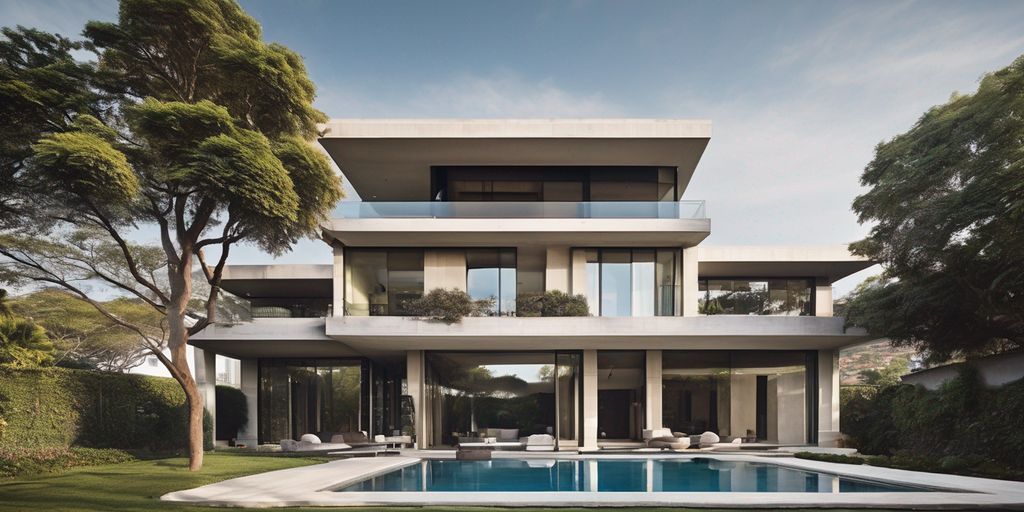From the quaint charm of villas to the towering presence of skyscrapers, architecture around the world has evolved dramatically over the centuries. This article explores the journey of home styles globally, from historical designs to modern innovations, and how cultural, technological, and social influences have shaped the spaces we call home.
Key Takeaways
- The International Style revolutionized modern architecture with its emphasis on minimalism and functionality.
- The adaptation of architectural styles across different cultures showcases the global influence and versatility of design principles.
- Technological advancements have significantly impacted home design, leading to smarter, more sustainable living spaces.
- The decline of the International Style highlighted the need for more personalized and culturally resonant architectural designs.
- Sustainability has become a central focus in contemporary architecture, promoting environmentally friendly and energy-efficient practices.
The International Style: Concepts, Styles, and Trends

Naming the New Architecture
The term International Style was first coined to describe a type of architecture that emerged in the 1920s, characterized by an emphasis on volume over mass, the use of lightweight, industrial materials, and a rejection of historical styles. This style was formalized at the 1932 Museum of Modern Art exhibition curated by Henry-Russell Hitchcock and Philip Johnson, which showcased this new architectural approach.
Later Developments
As the International Style evolved, it began to incorporate more flexible and dynamic elements, allowing for more individual expression within the architectural framework. Significant advancements in technology and engineering influenced these developments, leading to the creation of more functional and adaptable building designs.
Global Expansion
The International Style quickly spread beyond Europe to the United States and eventually to other continents. This expansion was facilitated by the global movement of architects and the international discourse on modernist principles. The style’s adaptability made it suitable for various climates and cultural contexts, leading to its widespread adoption and adaptation.
Principles of Building Design

Home
The concept of home transcends mere physical structures to embody feelings of safety, comfort, and belonging. Designing a home involves more than aesthetics; it requires a deep understanding of the occupants’ needs and desires. This holistic approach ensures that every space within the home serves a purpose, enhancing the quality of daily life.
3D Services
In the realm of building design, 3D services have revolutionized how architects and designers plan and visualize spaces. From detailed walkthroughs to structural adjustments before construction, these tools offer a comprehensive view that helps in making informed decisions. The use of 3D modeling in building design not only saves time and resources but also allows for greater creativity and precision.
Portfolio
A portfolio is a critical tool for any architect, showcasing their range and depth in various design projects. It reflects their philosophy and skill, attracting clients who resonate with their aesthetic and functional sensibilities. A well-curated portfolio is not just a collection of past works; it is a testament to the architect’s ability to adapt and innovate in the face of evolving design challenges.
Types of Architecture: 12 Architectural Styles

The Coalescence of the International Style
The International Style, a term first coined in 1932, marked a significant shift in architectural design, emphasizing volume over mass, balance rather than preconceived symmetry, and the expulsion of ornamental excess. This style’s global influence was profound, setting the stage for modern architectural practices.
Early Dissemination to the United States
The International Style quickly permeated American architecture after its introduction at the 1932 MoMA exhibition. It was characterized by an adoption of industrial materials like steel and glass, which facilitated the minimalist aesthetic and functional form that became synonymous with American skyscrapers and corporate buildings.
Transformative and Political Aspects of the International Style
The International Style was not just an architectural trend but a political statement, advocating for social change through design. It promoted transparency and simplicity, reflecting the democratic values that were believed to be integral to the modern age. This style played a crucial role in shaping the urban landscapes of the mid-20th century, influencing both residential and commercial architecture.
Later Developments – After the International Style

New Directions for Architecture
Following the decline of the International Style, architects sought new inspirations and methodologies, leading to a diverse range of architectural expressions. This period was marked by an exploration of post-modernism and deconstructivism, as well as a renewed interest in environmental sustainability and local cultural identities.
Legacy
The International Style’s emphasis on simplicity and functionality has left a lasting impact on modern architecture. Many contemporary buildings still reflect its principles, albeit adapted to new materials and technologies. The style’s legacy continues to influence how architects think about space, form, and the urban environment.
Useful Resources
For those interested in exploring this architectural period further, numerous resources are available:
- Books and journals on post-International Style movements
- Online courses and lectures on architectural history
- Archives and exhibitions showcasing significant post-International Style projects
An ‘Unofficial’ American Architecture

The Destruction of World War I and Rebuilding Efforts
The aftermath of World War I catalyzed a significant shift in American architecture, steering away from European influences towards more localized, innovative designs. This period marked the genesis of what would later be recognized as American modernism, a style that was not officially codified but was distinctly American in its essence.
The Decline of the International Style
As the 20th century progressed, the once-dominant International Style began to wane in the United States. Architects started to explore new forms and materials, leading to a diversification of styles that reflected a broader range of cultural and regional influences. This evolution was pivotal in shaping the modern American architectural landscape.
The heyday of the International Style
During its peak, the International Style had a profound impact on American architecture, introducing minimalist aesthetics and an emphasis on function. The style’s principles were widely adopted, but over time, they were adapted to incorporate more American characteristics, blending the international with the local to create a unique architectural identity.
Global Influence and Adaptation

The Rise of Skyscrapers
The 20th century marked a significant shift in architectural designs with the rise of skyscrapers. These towering structures not only transformed city skylines but also symbolized modern economic power and technological advancement. Skyscrapers utilized steel-frame construction, allowing buildings to reach unprecedented heights.
Cultural Adaptations in Home Styles
As architectural styles spread globally, they adapted to local cultures and climates. This adaptation ensures that even though a style may originate from one area, it can be tailored to fit the environmental and cultural needs of another, making architecture a truly global art form.
Modern Challenges and Innovations
The architecture industry today faces numerous challenges, including sustainability and the integration of technology. Innovations such as smart homes and green buildings are becoming increasingly prevalent, addressing both environmental concerns and the demand for higher living standards.
Architectural Evolution in Residential Spaces

From Villas to Modern Homes
The transition from traditional villas to modern homes encapsulates the dynamic evolution of residential architecture. This shift reflects a broader trend towards maximizing both aesthetic appeal and functionality in living spaces. Key elements such as open floor plans, minimalistic designs, and the integration of natural elements are now predominant.
Integration of Technology in Home Design
Incorporating technology into home design has become essential for modern living. Smart homes, equipped with automated systems for lighting, heating, and security, are becoming the norm. The use of sustainable materials and technologies also plays a crucial role in modern constructions, aiming to reduce environmental impact while enhancing efficiency.
Sustainability in Architecture
Sustainability has become a cornerstone in contemporary architecture. Architects are increasingly focusing on energy-efficient designs and eco-friendly materials. The goal is to create spaces that are not only aesthetically pleasing but also have a minimal environmental footprint. Strategies include the use of solar panels, green roofs, and energy-efficient appliances.
Conclusion
From the quaint charm of villas to the towering presence of skyscrapers, the journey of home styles across the globe is a testament to the evolution of architectural design and cultural influences. This article has traversed through various epochs and regions, exploring how the International Style emerged, evolved, and eventually paved the way for new architectural directions. As we’ve seen, each style not only reflects the technological advancements and aesthetic preferences of its time but also the socio-economic contexts that shaped them. The global journey of home styles is not just about the structures themselves, but about the stories they tell and the lives they house, making each building a unique landmark in the vast landscape of human history.
Frequently Asked Questions
What is the International Style in architecture?
The International Style refers to a major architectural style that emerged in the 1920s and 1930s, characterized by an emphasis on volume over mass, the use of lightweight, mass-produced industrial materials, and the rejection of historical precedents in decor and layout.
How did the International Style influence global architecture?
The International Style became a global architecture paradigm, influencing urban planning and building designs worldwide. It emphasized functionalism and minimalism, impacting both residential and commercial architecture.
What led to the decline of the International Style?
The decline of the International Style was due to its perceived monotony and soullessness, especially in large-scale implementations. Critics argued it failed to accommodate local contexts and human needs, leading to a search for new directions in architecture.
What are some iconic projects of the International Style?
Iconic projects include the Plan for Brasilia, Brazil, Chase Manhattan Bank, and Case Study House #22 (Stahl House), which exemplify the style’s principles and aesthetic.
How did the International Style address post-war rebuilding efforts?
The International Style played a significant role in post-war rebuilding, offering a modernist, efficient approach to construction that was seen as a way to break away from the past and embrace a new, functional future in urban development.
What are the modern challenges faced by architects influenced by the International Style?
Modern challenges include addressing the criticisms of the style’s earlier implementations, such as improving social integration, environmental sustainability, and adapting to technological advancements while maintaining aesthetic and functional principles.



